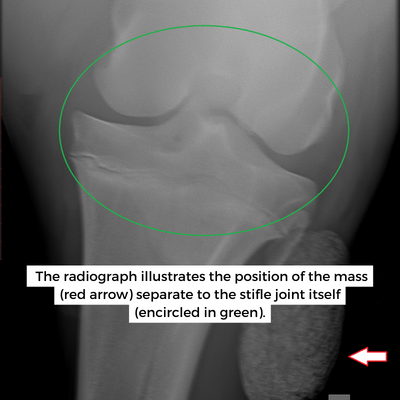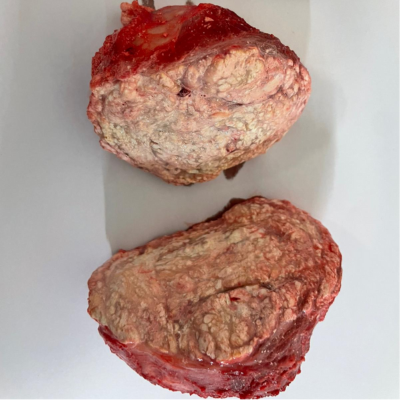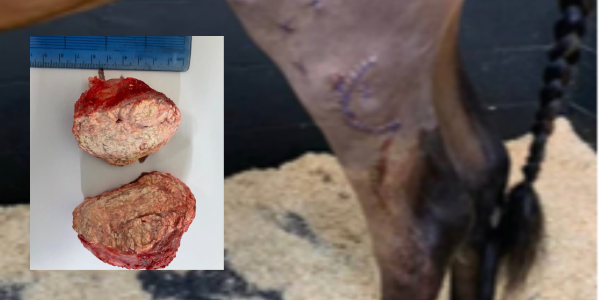A calcinosis circumscripta conundrum
A CALCINOSIS CIRCUMSCRIPTA CONUNDRUM
Occasionally as a vet, there are cases that exercise our brains VERY hard! This was certainly the case with Zeus, a two year old gelding.
Zeus was found severely lame on his left hind limb whilst out grazing. On initial clinical examination, no localising signs could be found to explain the lameness. Intravenous pain relief was administered to facilitate returning Zeus to his stable. After 48 hours, his owners noted that some swelling had started to develop in the region of the stifle. Zeus was examined on yard to establish his fitness to travel, before coming into clinic for further investigations.

CLINIC INVESTIGATIONS
A large swelling within the muscle belly on the outer aspect of the limb was found 10cm below the stifle joint, which was severely inflamed.
X-rays revealed the swelling in the muscle belly to be a discrete mineralised mass, consistent with the appearance of a tumour, chronic abscess or calcinosis circumscripta. Radiography of the stifle joint itself was unremarkable.
Ultrasonography confirmed severe inflammation of the joint, with some damage to the stabilising ligamentous structures on the outer aspect of the joint. Ultrasonography of the mass revealed that it incorporated the overlying long digital extensor tendon.
Synoviocentesis (removal of synovial fluid) was performed on the joint. Instead of the small amount of transparent, straw-coloured fluid expected, an abundance of cloudy, cream fluid was obtained. This fluid underwent rapid analysis at Oakhill, where it was found to have a white blood cell count highly suggestive of infection of the joint although slightly bizarrely, no bacteria could be identified.
The question was, were the two findings (the muscle mass and the stifle joint inflammation) related? What was certain was that the extremely painful, inflamed joint required arthroscopic (keyhole) flushing under general anaesthetic to give Zeus a reasonable chance of recovery. Whilst the exact nature of the mass remained uncertain, it was decided that removal was the best plan of action.

WILL SURGERY PROVIDE MORE ANSWERS?
Equine surgery specialists Guy and Rosie operated together to minimise the length of the general anaesthetic. The mass was carefully excised, along with a portion of the affected tendon. The mass was found to contain a white, grit or chalk like substance – some of which appeared to be tracking up the tendon towards the joint! The joint was accessed separately via keyhole surgery allowing the abnormal fluid to be flushed out thoroughly and the thickened joint lining to be debrided. Much to the surprise of the surgeons, the same white chalky substance found in the mass appeared to be within the joint fluid as well. Zeus recovered well from surgery with the mass removed and a much healthier stifle joint.
The mass and synovial fluid were sent to an external lab for examination by a pathology specialist. This concluded that the mass was calcinosis circumscripta – an unusual condition characterised by the formation of a discrete, fibrous, mineralised mass under the skin, the cause of which is unknown.
Fluid analysis found white blood cell levels consistent with the initial findings at the clinic, but despite such high white blood cell levels normally only being recorded with joint infection, no bacteria were observed under microscope and no bacteria could be grown. The presence of calcified debris within the fluid was also confirmed.
Calcinosis circumscripta usually remains as a single defined mass. However, in Zeus’s case material from the mass appeared to have tracked up the tendon and penetrated the joint before causing extreme aggravation of the joint surface resulting in a severe inflammatory response.
Whilst Zeus remains a phenomenon of veterinary medicine, his recovery to date is extremely promising. He is now back enjoying being a youngster in the field with his friends prior to a check-up and medication of the joint at ten weeks post surgery!



